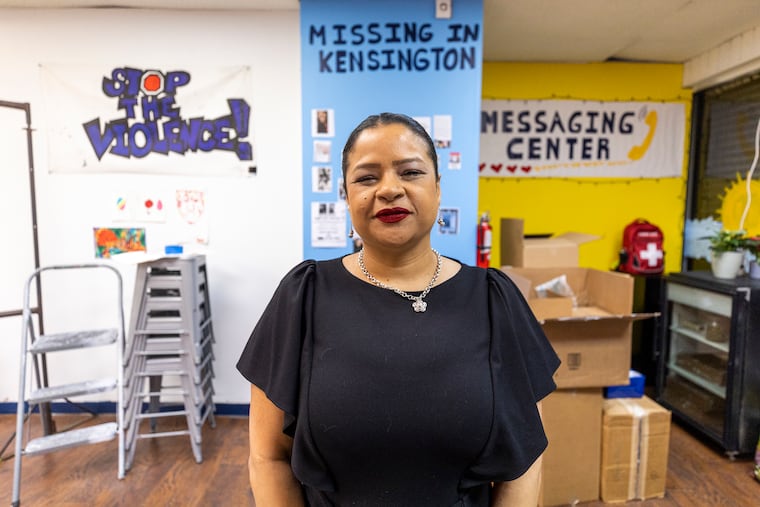As city officials promise a crackdown on the dark side of Kensington, one community activist focuses on the sunshine
Sunshine House offers hope in one of the city’s poorest neighborhoods, offering everything from a hot cup of coffee to a shoulder to cry on.

The woman’s wails announced her arrival.
It was her birthday, she sobbed as she walked through the door, and she missed her father.
But no matter how much the woman, small and gaunt and inconsolable, cried out for her dad, there was nothing Rosalind “Roz” Pichardo could do.
The woman’s father had died some time ago. Her tears were for a life that could never be fully recaptured, not even on her birthday.
Pichardo hugged her tight and let her cry.
Reconnecting families was among Pichardo’s top priorities when she reopened the old Kensington Storefront in the epicenter of Philadelphia’s opioid crisis last month.
Sometimes she’s successful, sometimes she’s not. That’s often the reality of Kensington. Even with compassionate people who want nothing more than to help, yet still the results can be so cruel.
After the old storefront — an artistic and community hub that also served people in addiction — closed during the pandemic, Pichardo, 46, had one singular objective: to reopen it in the same spot at 2774 Kensington Ave.
She renamed it the Sunshine House, a nod to what she calls people in active addiction: her Sunshines.
Much as it did in its prior incarnation, Sunshine House offers hope in one of the city’s poorest neighborhoods — through art, music, and crafts, and whatever else Pichardo can bring to the small space. She also educates people on the front lines of the epidemic on reversing overdoses and treating gunshot wounds, some of the services she’s long offered through her nonprofit, Operation Save Our City.
It’s a safe haven in the midst of chaos, where those in need can access welcome essentials, be it a hot cup of coffee, a warm pair of socks, or a shoulder to cry on.
Among the first things Pichardo did when she opened the center, in the shadow of the Market-Frankford El’s Somerset Station, was set up a messaging center where her Sunshines and families desperate to connect with them could communicate.
The longtime community activist, who once worked and volunteered in the old space, hopes Sunshine House will become a centralized location for families who routinely travel to Kensington from all over to safely search for loved ones. Messages can also be left by calling 267-804-7166.
A wall is already filling up with photos of missing friends and family members, brothers and sisters, nieces and nephews, mothers and fathers.
Like many Philadelphia residents, I’ve been watching Mayor Cherelle L. Parker’s Kensington initiative with a mix of hope and skepticism.
For far too long, people who don’t live anywhere near the neighborhood have had a lot of ideas — and say — about what’s best for the community.
“I want you to know that the status quo for me and Kensington is unacceptable,” Parker said during her comments at the Greater Philadelphia Chamber of Commerce’s annual Mayoral Luncheon in February. She added that she would prioritize “the voices and hopes of the people who actually live in Kensington.”
“Help is on the way,” she said.
I’m just not sure Parker and I share the same definition of help in this case. Last month, while discussing her proposed budget, she said “not one city dollar” will fund syringe exchange. Yet, there is ample evidence that clean syringes reduce the transmission of HIV, hepatitis B, and other diseases that will only soar without access on these streets.
I visited Pichardo a couple of weeks after her opening to get her thoughts on some of the changes in Kensington, those already rolled out, and those still in the works: increased police presence, new legislation requiring some Kensington businesses to adhere to a curfew, and a plan for triage and wellness facilities for people in addiction. All for a promised new day.
One of the biggest concerns echoed all over the neighborhood is that the latest initiatives will only accelerate the ongoing gentrification of a place where residents, often with no other choice, hung on only to be cut out of its better days.
“Are we going to be here in the end?” Pichardo said.
There is no lack of Kensington residents with “real-life lived experience,” as Parker is fond of saying when discussing her own life, with valid and valuable and — yes — sometimes opposing opinions on how best to fix the neighborhood they love deeply.
Pichardo is one of those people. She’s lived in Kensington her whole life. She has family and friends and countless Sunshines who have struggled with addiction. Some have made it out. Many have not.
Residents, she acknowledged, have long deserved better than having to navigate a humanitarian crisis on their own, and the people in active addiction deserve more than being neglected or exploited or politicized — sometimes all three.
And yet, that’s the intersection we’ve been stuck in for decades, isn’t it?
We’re at a virtual standstill at the corner of indifference and acceptance. And only a jump-start of compassion and thoughtful action can get us on the right road again.